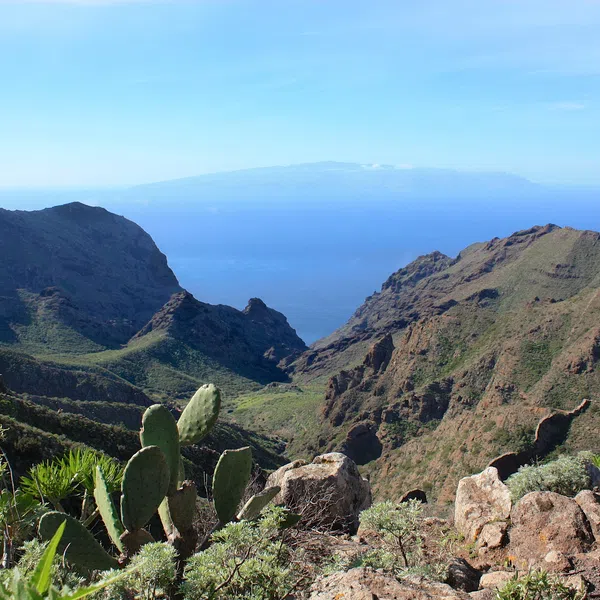La Gomera is the second smallest of the
Canary Islands. The whole island counts nowadays about 24,000 inhabitants, and the capital city is
San Sebastián de La Gomera. La Gomera has an area of 369 square kilometers and its highest peak is called
Garajonay, 1,487 meters high, located in the
Garajonay National Park. The climate in La Gomera is mild throughout the whole year, with few fluctuations and an average temperature of twenty-two degrees all year long (with maximum peaks of 35 °in the summer months and a minimum temperature of 18 ° in April), which makes it an ideal destination in every season. La Gomera is an excellent nature-based tourism destination, with lots of activities related to sport, culture, and history.
Nature
Difficult to say whether you are in Europe or in the Caribbean: beautiful clear sea and the green landscape made of palms, agaves, banana trees. In the green valleys, there is an abundance of avocados, cilantro, mangos, dates, "mojo" (hot pepper), tomatoes, papayas (try the papaya smoothie in the "zumerias" of the island), guayabas, and luxuriant bougainvilleas, hibiscuses, sterlitzias, and poinsettias, which make this island a tropical green paradise on Europe's doorstep. La Gomera presents the perfect combination of sea and mountains (reaching 1500 meters), where miradores open up on breathtaking views, as the famous Mirador de Palmarejo, designed by the artist Cesar Manrique on the road to Valle Gran Rey. Valle Gran Rey is worth a visit because of picturesque fishing villages with colorful boats and some of the finest beaches on the island. Under the rocks, on the doorstep of a lush valley, you can take the boat for the trip to Los Organos, a huge organ sculpted in basalt cliff that you can only fully enjoy from the water, on the northern part of the island.
La Gomera Punto Panoramico Sport and culture
La Gomera is a paradise for sports lovers: scuba diving, surfing (very popular is playa de Santa Catalina, in the north-east part of the island), deep-sea fishing (tuna and marlin in abundance) and sailing, tennis, mountain biking, horseback riding, golf. In the south of the island, there is the Golf Resort Tecina, considered one of the most scenic golf courses in the world. In addition to the powerful vegetation, it offers an extraordinary view of the ocean and the best view of the volcano Teide from the island. Last but not least, La Gomera island is ideal for walking and hiking: you could walk around for a whole week without ever walking the same paths. The island’s surface has indeed many marked trails. They are the same paths walked in the past by the Gomeros who, in order to overcome the difficult communications through the mountains, invented a "sound language" based on powerful whistles that allowed them to communicate even at very large distances, still known by few: the "Silbo", recognized by UNESCO as immaterial human patrimony.
San Sebastián de la Gomera, La Gomera, España Laurel forest: the jewel of the island
La Gomera is a rocky island with a green heart: the Parco Nacional de Garajonay which, with its 4000 hectares, covers about ten percent of the island’s territory. This national park takes its name from the legend of an unfortunate love between two young lovers, Gara and Jonay. It was the first natural park to become UNESCO’s World Heritage in 1986, which at that time included only historical and artistic sites. At the center of the park, we find a true jewel: the forest of laurel plants, one of the oldest forests of the planet hosting numerous species of laurel, plus hundreds of different other plants - ferns, lichens, shrubs, lianas, mosses. It is a breathtaking forest that stays green all year long thanks to the effect of the trade winds. The trade winds, combined with warmer breezes give life to a permanent mist, called "horizontal rain," typical of this forest.
Il bosco di laurisilva, La Gomera, España Typical dishes
The Guarapo is the delicious palm honey typical of La Gomera. It is extracted from the bark of the 170,000 typical Canary palms that grow on the island, more than all the palms of the Canary archipelago together. This sweet
Visit La Gomera
-
- The people* :It’s the second smallest of the Canary Islands, well known for the kind nature of its inhabitants and the great quality of its products.
-
- The hiking paths* :The island is a hikers’ paradise with more than 600km of hiking tracks all over its territory!
-
- The Nature* :Attention nature lovers! 33% of its surface is legally protected, it hosts different ecosystems and many various vegetation types.
-
- Biodiversity* :There are a lot of endemic plants and animal species on the island Gomera, making it one of the territories with more endemism per square kilometre in the whole European Union.
-
-
- The climate* :The climate in La Gomera is mild throughout the whole year, with maximum peaks of 35 °in the summer months and a minimum temperature of 18 ° in April, making it an ideal destination in every season.
-
- The giant lizards* :The island is the home of the giant lizard of La Gomera, one of the world's most endangered species. Happily, this unique animal is currently in the process of recovery.
-
- The beaches* :There are countless beaches located between breathtaking cliffs for all tastes: sandy, with pebbles or rocks, and all located on crystal clear seawater.
-
- The forests* :The forest of "El Cedro" is a true relic of the Tertiary, and a world reserve for the conservation of "laurisilva" (lauriel).
-
- The geological history* :Over 12 million years of geological history created a radial network of deep beautiful ravines.
